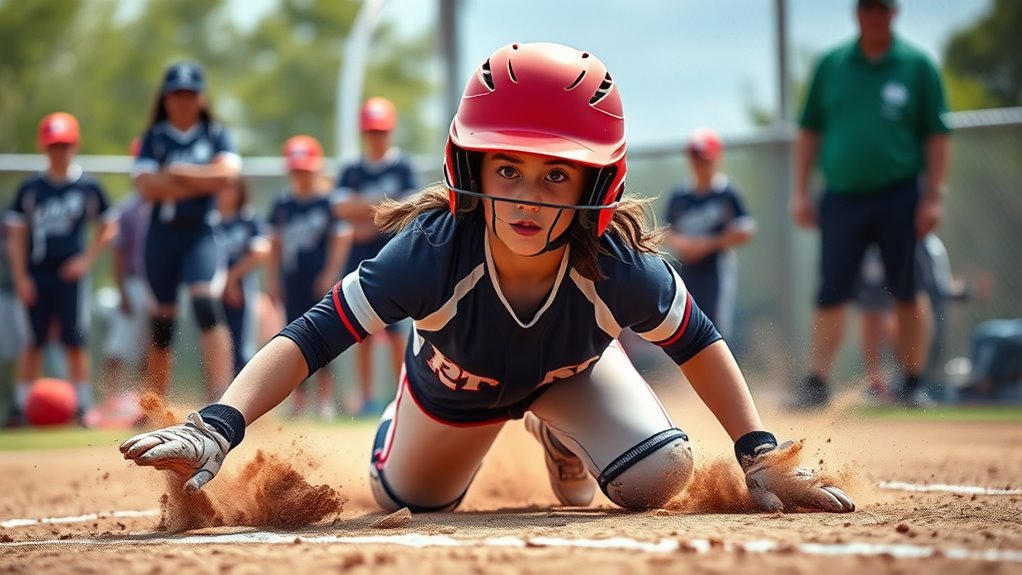To keep your softball star healthy and injury-free, focus on proper training techniques that emphasize correct form, strength, and control. Make sure safety gear like helmets, gloves, and cleats fit well and are in good condition. Promote consistent use of protective equipment during practice and games, and create a safe environment with warm-ups, hydration, and hazard checks. Staying proactive with safety measures builds confidence and prevents injuries—continue exploring ways to support your star’s well-being.
Key Takeaways
- Ensure proper training techniques and muscle strengthening to prevent shoulder and elbow injuries.
- Regularly inspect and maintain all equipment to ensure safety and proper fit.
- Mandate consistent use of protective gear during practice and games for injury reduction.
- Promote warm-up routines, hydration, and hazard-free environments to minimize injury risks.
- Foster a safety-first culture emphasizing technique, equipment safety, and open communication.

Ensuring your softball star stays healthy and injury-free requires proactive safety measures both on and off the field. One of the most effective ways to accomplish this is by focusing on proper training techniques and equipment safety. When it comes to training, you want to emphasize correct form and technique to prevent unnecessary strain or injury. For example, teaching your player how to properly throw and swing can reduce the risk of shoulder or elbow injuries. Incorporate drills that emphasize muscle memory and control, guaranteeing they develop good habits that will last a lifetime. Strengthening exercises tailored to softball movements can also help build resilience, making muscles and ligaments more resistant to injury. Remember, quality training isn’t just about practicing skills; it’s about doing so safely and deliberately, avoiding rushed or careless repetitions that could cause harm. Using diverse and innovative training aids can further enhance safety and effectiveness during practice sessions.
Equipment safety plays a vital role in keeping your softball star injury-free. Start by regularly inspecting all gear—bats, gloves, cleats, and protective equipment—to guarantee they’re in good condition. Worn-out gloves or cracked helmets may seem minor but can lead to serious injuries during play. Properly fitted equipment is equally important; ill-fitting helmets or pads can shift during action, reducing protection and increasing the risk of impact injuries. Make sure your player wears a well-fitted helmet with a secure chin strap, and that pads and gloves fit snugly without cutting off circulation. Additionally, encourage your player to wear appropriate footwear—cleats that provide enough grip and support to prevent slips or twisted ankles. Educate them on the importance of using safety gear consistently, not just during practice but also in games. This habit helps instill a safety-first mindset, reducing the temptation to cut corners.
Beyond equipment and technique, creating a safe environment is essential. Warm-up routines that include stretching and dynamic movements prepare muscles for activity and reduce the chance of strains. Hydration and proper nutrition support overall health and recovery, helping your softball star stay energized and resilient throughout the season. Encourage open communication so they feel comfortable reporting discomfort or potential hazards they notice during practice or games. By combining proper training techniques with sound equipment safety practices, you help lay a foundation for your player’s longevity and enjoyment of the game. Prioritizing safety not only prevents injuries but also builds confidence, ensuring your softball star can perform at their best without unnecessary risks.
Frequently Asked Questions
How Can Parents Best Support Injury Prevention Efforts?
You can best support injury prevention by maintaining open parental communication, encouraging your child to share any discomfort or concerns. Promote injury education by teaching your softball star about proper techniques, the importance of warming up, and recognizing early signs of injury. Stay involved in their training routines, monitor their equipment, and make certain they follow safety guidelines. Your active support and education help minimize risks and keep your child healthy and confident on the field.
What Are Signs of Overtraining in Young Softball Players?
Think of overtraining as wearing out your favorite pair of shoes; it shows signs before breaking. You might notice fatigue symptoms like constant tiredness, sore muscles, or decreased performance. Training overload can lead to irritability, lack of enthusiasm, or frequent injuries. Keep a close eye on these signs, and remember, rest is just as important as practice. Listening to your young athlete’s body helps prevent burnout and keeps her game strong.
How Does Proper Hydration Impact Injury Risk?
Proper hydration is vital because it helps prevent injuries by keeping your muscles and joints functioning well. When you stay hydrated, you reduce the risk of cramps, strains, and heat-related illnesses. Focus on fluid intake strategies like drinking water regularly before, during, and after practice or games. Remember, hydration importance can’t be overstated—staying well-hydrated keeps your body in top shape and minimizes injury chances.
Are There Specific Warm-Up Routines Recommended for Softball?
When preparing for softball, you should focus on dynamic stretches, muscle activation, and sport-specific drills. Dynamic stretches help increase blood flow and flexibility, while muscle activation warms up key muscles used during play. Incorporate arm circles, leg swings, and lunges to prime your body. By doing these routines consistently, you reduce injury risk, improve performance, and guarantee you’re ready to hit the field confidently and safely.
When Should a Player See a Healthcare Professional After an Injury?
You should see a healthcare professional immediately after an injury if you experience severe pain, swelling, or inability to move the affected area. For minor injuries, seek medical consultation if symptoms worsen or don’t improve within a few days. Prompt medical advice guarantees proper injury recovery, reduces the risk of complications, and helps you get back on the field safely. Trust your instincts and don’t delay seeking help when needed.
Conclusion
Remember, an ounce of prevention is worth a pound of cure. By prioritizing proper warm-ups, wearing the right gear, and listening to your body, you can help keep your softball star healthy and injury-free. Staying proactive not only extends their playing time but also builds confidence on the field. So, stay vigilant and always put safety first—because when it comes to your athlete’s health, it’s better to be safe than sorry.









